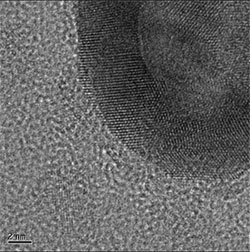SALT LAKE CITY, March 23, 2009 – By attaching a short peptide to hollow gold nanospheres, researchers have developed a way for the particles to seek out and “cook” cancer cells, according to the American Chemical Society.
The cancer-destroying nanospheres show particular promise as a minimally invasive future treatment for malignant melanoma, the most serious form of skin cancer, the researchers say. Melanoma now causes more than 8000 deaths annually in the US alone and is on the increase globally.
Researchers say that, by attaching a protein fragment, the nanospheres are drawn directly to melanoma cells, while avoiding healthy skin cells. After collecting inside the cancer, the nanospheres heat up when exposed to near-infrared light, which penetrates deeply through the surface of the skin. In recent studies in mice, the hollow gold nanospheres did eight times more damage to skin tumors than the same nanospheres without the targeting peptides, the researchers say.
Partial view of a gold nanosphere, magnified by a factor of 1 billion, is seen through an electron microscope. The darker ring shows the “wall” of the nanosphere, while the lighter area to the right of the ring shows the interior region of the shell. (Image courtesy of Adam Schwartzberg and Jin Zhang)
“This technique is very promising and exciting,” explained study co-author Jin Zhang, a professor of chemistry and biochemistry at the University of California, Santa Cruz. “It’s basically like putting a cancer cell in hot water and boiling it to death. The more heat the metal nanospheres generate, the better.”
This form of cancer therapy is actually a variation of photothermal ablation, also known as photoablation therapy (PAT), a technique in which doctors use light to burn tumors. Because the technique can destroy healthy skin cells, doctors must carefully control the duration and intensity of treatment.
Researchers now know that PAT can be greatly enhanced by applying a light absorbing material, such as metal nanoparticles, to the tumor. Although researchers have developed various types of metal nanoparticles to help improve this technique, many materials show poor penetration into cancer cells and limited heat-carrying capacities. These particles include solid gold nanoparticles and nanorods that lack the desired combination of spherical shape and strong near-infrared light absorption for effective PAT, scientists say.
To develop more effective cancer-burning materials, Zhang and colleagues focused on hollow gold nanospheres – each about 1/50,000th the width of a single human hair. Previous studies by others suggest that gold “nanoshells” have the potential for strong near-IR light absorption. However, scientists have been largely unable to produce them successfully in the lab, Zhang noted.
After years of research toward this goal, he announced in 2006 that he had finally developed a nanoshell or hollow nanosphere with the “right stuff” for cancer therapy: gold spheres with an optimal light absorption capacity in the near-IR region, small size and spherical shape, perfect for penetrating cancer cells and burning them up.
“Previously developed nanostructures such as nanorods were like chopsticks on the nanoscale,” Zhang said. “They can go through the cell membrane, but only at certain angles. Our spheres allow a smoother, more efficient flow through the membranes.”
The gold nanoshells, which are nearly perfect spheres, range from 30 to 50 nm – thousands of times smaller than the width of a human hair. The shells also are much smaller than other nanoparticles previously designed for photoablation therapy, he said. Another advantages is that gold is safer and has fewer side effects in the body than other metal nanoparticles, Zhang noted.
In collaboration with Chun Li, a professor at the University of Texas M.D. Anderson Cancer Center in Houston, Zhang and his associates equipped the nanospheres with a peptide to a protein receptor that is abundant in melanoma cells, giving the nanospheres the ability to target and destroy skin cancer. In tests using mice, the resulting nanospheres were found to be significantly more effective than solid gold nanoparticles because of much stronger near-IR light absorption of the hollow nanospheres, the researchers say.
The next step is to try the nanospheres in humans, Zhang said. This requires extensive preclinical toxicity studies. The mice study is the first step, and there is a long way to go before it can be put into clinical practice, Li said.
The US Department of Defense and the National Science Foundation funded the research in Zhang’s lab, while the National Institutes of Health funded the work in Li’s lab.
For more information, visit: www.acs.org